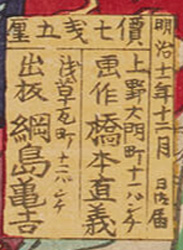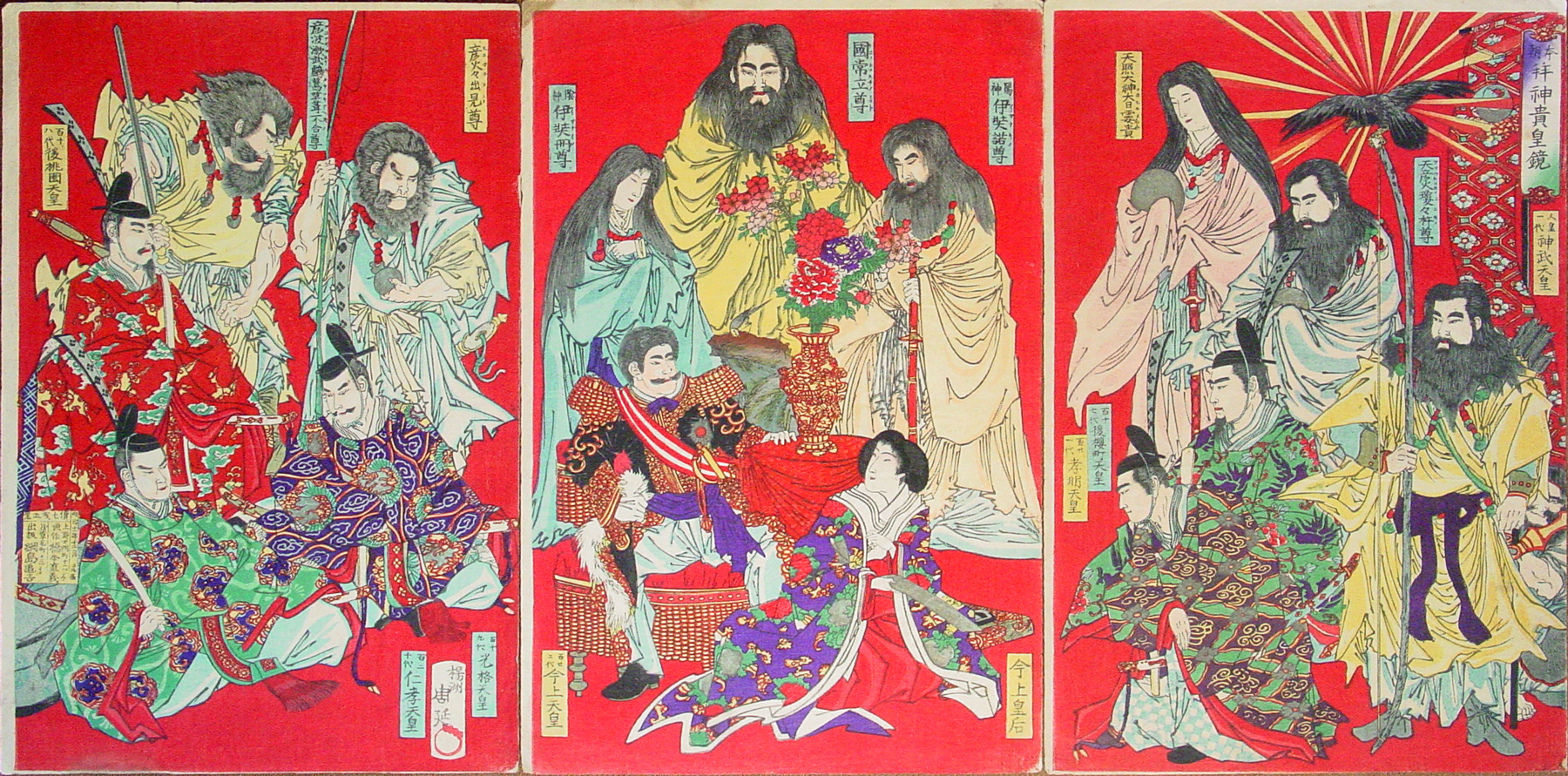About This Print
Source: Chikanobu: Modernity and Nostalgia in Japanese Prints, Bruce A. Coats, Hotei Publishing, 2006, p. 73.In the 1870s and 1880s, a number of print artists depicted the imperial lineage for informational and propaganda purposes. Usually the composition showed the 122nd emperor of Japan, Mutsuhito (1852-1912, posthumously known as the Meiji Emperor), and his consort Ichijo Haruko (1850-1914, posthumously known as Empress Shoken), in the center sheet of a triptych composition, with deities and past emperors gathered around.
Here Chikanobu presents the primordial deity Kunitokotachi no mikoto above them, flanked by the two deities of Ise, Yojin at right and Injin at left. The first emperor Jimmu is at far right, holding a bow on which an eagle [actually the mythical Yatagarasu, or three-clawed crow, sent by Amaterasu to guide Jimmu through a difficult part of his eastward journey] is alighting. Next to Jimmu are the 117th emperor Go-Sakuramachi (reigned 1763-1770) and Mutsuhito's father the 121st emperor Komei (reigned 1847-1866), below the deities Ninigi no mikoto (also known as Susa-no-o, the Storm God) and his sister Tensho daijin (also known as Amaterasu Omikami) who is holding a mirror, emblem of the sun and one of the sacred treasures of the imperial family. On the other side are the deities Hikohoho demi no mikoto, holding a fishing pole, and his brother Ugayafuki aezu no mikoto with a sword, standing above the 118th emperor Go-Momonozono (r. 1771-1779), the 119th emperor Kokaku (reigned 1780-1817) and the 120th emperor Ninko (reigned 1817-1846).
Also see the article Prints of the Emperor Meiji and Empress Haruko.
PowerPoint Presentation Notes from 1-31-2017 Presentation
Mirror of Our Country’s Revered Deities and Esteemed Emperors, December 1878 Following the Satsuma Rebellion, anumber of prints were issued depicting the emperor and his officialimperial lineage.As inthis print, the usual composition showed Emperor Meiji and Empress Shokenfront and center, surrounded by Shinto deities, past emperors, and the ThreeSacred Treasures - the sword, mirror and jewel. Emperor Jimmu, Japan’sfirst emperor, sitson the right holding a bow on which the mythical three-clawed crow sent by thesun goddess to guide him alights.
Let’s start by looking at a print issued in 1878 shortly after the end of the Satsuma Rebellion. One of a number of similar prints depicting the imperial lineage, we see Emperor Meiji and Empress Shoken in the center surrounded by Shinto deities and past emperors. The emperor is shown in military uniform, as he is in virtually all kaika-e, while the empress wears traditional robes, although later prints, as we’ll see, often show her in Western dress. The first emperor, Jimmu, is shown on the right holding a bow on which the mythical three-clawed crow sent by the sun goddess to guide him alights.
Note the glaring red background of this print, a color that became synonymous in the print industry with modernity and was used with abandon. This is also a good time to point out the recurring elements in each of the prints we’ll see. In the upper right corner we see a colored cartouche with the title of the print, a number of small rectangular cartouches provide the names of the figures depicted; in the left panel we see a cartouche with the artist’s signature (and seal), in this case that of Yōshū Chikanobu (1838-1912), and finally a yellow cartouche containing the publisher’s name and address and date of issuance.
Print Details
| IHL Catalog | #455 |
| Title or Description | Mirror of Our Country’s Revered Deities and Esteemed Emperors Honchō hiji kiō kagami 本朝拝神貴皇鏡 |
| Artist | Yōshū Chikanobu (1838-1912) |
| Signature |  |
| Seal | red Toshidama seal (as shown above) |
| Publication Date | December 1878 (as shown in Publisher below) |
| Publisher |  [Marks: pub. ref. 549; seal ref 26-087] 價七銭五厘 [price: 7 sen 5 rin] 画作 橋本直義 [artist: Hashimoto Naoyoshi] 出板 綱島亀吉 [publisher: Tsunajima Kamekichi] |
| Impression | excellent |
| Colors | excellent |
| Condition | good – 3 separate unbacked full-size sheets; minor soiling (including stain upper left corner center panel) edge wear and wrinkling |
| Genre | ukiyo-e; rekishi-e |
| Miscellaneous | |
| Format | vertical oban triptych |
| H x W Paper | 14 3/8 x 9 5/8 in. (36.5 x 24.4 cm) each sheet |
| Literature | Chikanobu: Modernity and Nostalgia in Japanese Prints, Bruce A. Coats, Hotei Publishing, 2006, p. 73-74, pl.42. |
| Collections This Print | Scripps College Ruth Chandler Williamson Gallery SC2005.1.56 |
| Reference Literature | "Al'Est du Nouveau" by Pierre-Francois Souyri, appearing in Le Figaro Histoire, Numéro 46, Octobre-Novembre 2019, p. 61 with credit to "Courtesy of the Lavenberg Collection of Japanese Prints" |
4/28/2021
4/19/2020
2/26/2020


